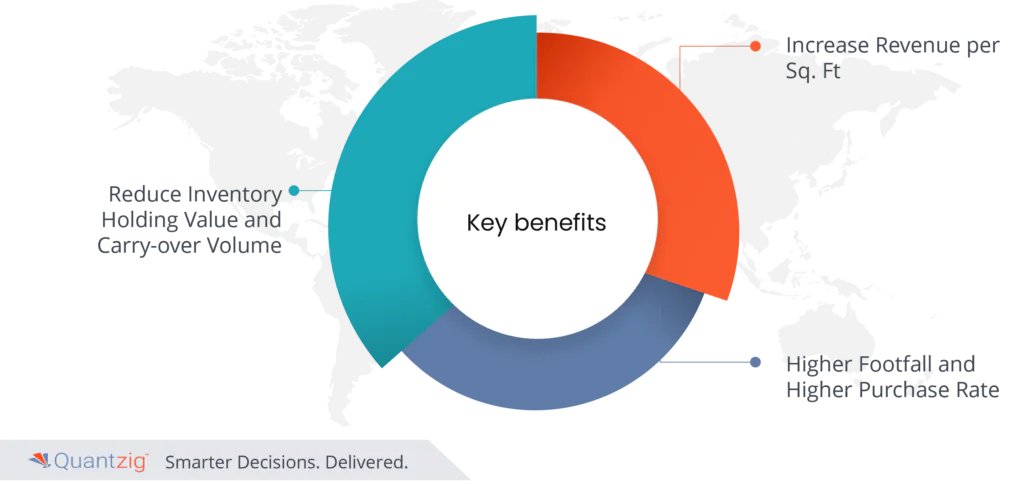Introduction to Assortment Optimization in Retail
In the fiercely competitive world of retail, staying ahead demands more than just offering products; it necessitates a strategic approach to stock optimization. This article explores the critical importance of Merchandising and assortment optimization strategies in the retail sector, focusing on their ability to customize distribution, enhance transaction efficiency, and drive tangible benefits. In this ever-evolving industry, where consumer preferences fluctuate, and trends shift rapidly, retailers must employ these strategies to customize their stock distribution, enhance transaction efficiency, and reduce costs, ultimately ensuring they remain at the forefront of the retail game.
Book a demo to experience the meaningful insights we derive from data through our ai analytics tools and platform capabilities. Schedule a demo today!
Request a Free DemoImportance of Merchandising and Assortment Optimization in the Retail Sector
1. Customizing Distribution Based on Hyper-local Needs
One size does not fit all in retail. Shoppers in one area may have distinct tastes, seasonal requirements, or cultural preferences compared to those in another. Merchandising and assortment in retail enable retailers to scrutinize local data and trends, empowering them to stock products that resonate with the specific clientele in each location. This customization enhances customer satisfaction and drives sales by ensuring that inventory matches the unique demand of the community.
2. Improving Units per Transaction per Customer
Increasing the efficiency of each transaction is essential for retail success. Through effective merchandising and assortment optimization, retailers can suggest complementary products, upsell, or cross-sell, leading to higher units per transaction per customer. This not only boosts revenue but also enhances the overall shopping experience. Shoppers who find it easy to discover and purchase relevant items are more likely to return, fostering customer loyalty and long-term profitability.
Top Benefits of Merchandising and Assortment Optimization in the Retail Sector

1. Reduce Inventory Holding Value and Carry-over Volume
Excessive inventory can be a financial burden for retailers. Merchandising and assortment optimization help in precisely managing inventory levels. This reduces the holding value of inventory and minimizes carry-over volume from one season to another. Lower inventory costs mean improved profitability.
2. Increase Revenue per Sq. Ft
Space in retail stores is valuable real estate. By optimizing product placement and assortment, retailers can increase revenue generated per square foot of store space. This efficiency is crucial in maximizing profitability and utilizing store space effectively.
3. Higher Footfall and Higher Purchase Rate
A well-optimized retail assortment strategy not only attracts more foot traffic to stores but also converts visitors into buyers. Shoppers are more likely to make a purchase when they find products that align with their needs and preferences. Higher footfall and purchase rates translate into increased sales.
Conclusion
Merchandising and assortment optimization are the cornerstones of retail success in today’s dynamic market. Customizing distribution, improving transaction efficiency, reducing inventory costs, and increasing revenue are all achievable through these strategies. Retailers that prioritize these practices will thrive in the ever-evolving retail landscape.
Quantzig’s Expertise in Merchandising and Assortment Optimization for a Leading IT Company
| Category | Details |
|---|---|
| Client Details | A leading IT Company in the United States, renowned for its diverse product portfolio and widespread presence. |
| Challenges Faced by The Client | Our client faced several challenges in their retail operations that include: – High Carry-Over Volume Each Season – Frequent Stockouts for Popular Sizes – High Inventory Holding Cost per Store – No growth in unique customers per store |
| Solutions Offered by Quantzig | Quantzig team captured price adjustments from different websites and systems for consolidation and aggregation to perform price optimization on the client’s various products. |
| Impact Delivered | – Shared real-time visibility of product prices, market share, and discounts – Created analytical capability to monitor and benchmark prices across geographies – Benchmarked product prices against competitor offerings – Analyzed online data for 1000+ price points across the client’s business product portfolio |
Client Details: A Leading IT Company in the United States
Challenges
Our client, a prominent IT company in the United States, faced several challenges in their retail operations:
High Carry-Over Volume Each Season: Excess inventory from previous seasons was a persistent issue, leading to financial losses.
Frequent Stockouts for Popular Sizes: The company struggled to maintain stock levels for popular sizes, resulting in lost sales opportunities.
High Inventory Holding Cost per Store: Maintaining inventory in their stores was costly and negatively impacted profitability.
No growth in unique customers per store: Stagnant growth in unique customers per store indicated a lack of expansion in their customer base and it resulted in limited market penetration and revenue growth opportunities.
Solutions
To address these challenges, our client implemented a range of merchandising and assortment optimization solutions:
Consumer Choice-Based Assortment Optimization Models: Leveraging data analytics, these models helped the company tailor their product offerings to match consumer preferences at a granular level.
Style and Size Level Sales Forecasting System: Accurate sales forecasting ensured the availability of popular sizes, reducing stockouts.
Category Walk-Out Minimizer Tool: This tool streamlined the assortment by identifying and eliminating underperforming categories, improving inventory efficiency.
Impact Delivered:
The results were impressive:

- 30% Reduction in Inventory Holding Costs: Efficient inventory management reduced the financial burden of holding excess stock.
- $14 Million per Store Type per Year Improvement in Revenue: Optimizing assortments and product placements led to substantial revenue growth.
- 37% Improvement in Footfall and 10% Improvement in Promo Uplift: The client’s stores experienced increased foot traffic and more effective promotional campaigns.
The success story of our client underscores the significant impact of merchandising and assortment optimization in the retail sector. To achieve similar results and drive your retail business to new heights, contact us today. Embrace these strategies and watch your profitability soar while enhancing customer satisfaction and efficiency.



